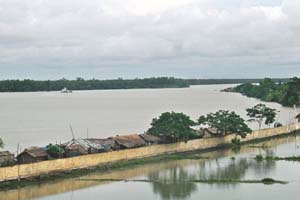Rampal Power Plant
Coal dust a big concern
Transportation of 3.2m tonnes of coal a year thru’ Passur river may threaten Sundarbans
 Even if emissions from the massive coal-fired Rampal Power Plant do not harm the Sundarbans that much, transport of imported coal through the Passur river may, experts say.
Even if emissions from the massive coal-fired Rampal Power Plant do not harm the Sundarbans that much, transport of imported coal through the Passur river may, experts say.
The Akram Point of the Sundarbans, where the Passur is two to three kilometres wide, will serve as the anchor point for the mother vessels of the imported coal.
From the Akram Point, smaller ships will load the coal from the mother vessels and carry them to the 1,320 megawatt plant site located beyond Mongla Port, says the Environmental Impact Assessment of the project.
The assessment was done by the Centre for Environment and Geographic Information Services (CEGIS), a reputed organisation.
To make the Akram Point navigable for mother vessels, the authorities would have to dredge around 16 km of the river, and dump its sediments in the Swatch of No Ground (SONG), a deep natural swatch in the Bay.
To be built by a company with equal shares of the Bangladesh Power Development Board and the Indian National Thermal Power Company, the plant will cost more than $1.5 billion.
The plant will need 3.2 million tonnes of coal a year. Imported coal on 80,000-tonne capacity ships will anchor at the Akram Point. From there, lighter ships will load coal containers with maximum 10,000-tonne capacity and transport them to the power plant’s jetty on the Passur. In other words, several smaller vessels carrying coal will ply the river every day, all the year round.
When the coal will be loaded on lighter vessels from mother vessels, some coal dust will spread in the river and the adjacent forest. While it may look insignificant on a day-to-day basis operation, it will in the long run pollute the river. And that will affect the adjacent mangrove forest, according to geologists.
An expert involved with the study, however, said coal from mother vessels would be transferred to smaller ships through a large funnel, equipped with sprayers and covers to ensure a minimum spread of dust.
“We believe this way only one to two percent of the dust may be released in the air and it will not have that negative an impact that might harm the forest,” he said.
Some critics are also against dumping the sediments obtained through dredging the Passur in the SONG. They say the SONG is the country’s only playground for two types of whales and dumping sediments there would affect its ecosystem.
But CEGIS experts rule it out as the deep SONG has been serving as one of the world’s biggest carriers of river sediments into the Bay for thousands of years. The sediments are carried up to Sri Lanka.
Bangladesh Environment Lawyers Association (Bela) earlier this year wrote to the CEGIS, expressing its concerns over making the Akram Point an anchorage area.
“The impacts of constructing the proposed Anchorage Area at Akram Point will be particularly severe because of the large scale of dredging [30 million cubic metres] that would be required for construction of this anchorage.”
This will badly affect the river, its estuary and the surrounding environment, Bela noted.
“The impacts of operating the proposed Anchorage Area at the Akram Point will include: 1) fugitive emissions and spills of coal from the transfer of coal from berthing mother ships to smaller barges; 2) emissions and noise from mother ships and smaller barges while idling at the proposed anchorage; and 3) impacts of ship movements to and from the proposed anchorage.
“All the coal carrying vessels, floating cranes, floating transfer vessels shall be equipped with dust suppression system. Such assessment of impact is qualitative, while quantitative assessment is a must,” Bela added.
The CEGIS responded to Bela by saying, “Since the Akram Point has been proposed as anchorage area, as such no major construction is envisaged on land. Due to unloading of coal at the Akram Point there may be insignificant or very little environmental impact on the adjacent land of the Sundarbans.
“The Akram Point is an open channel where the width of the river is more than two km. Both banks of the river are covered by mangrove forests. There is no other installation or significant infrastructure to mention.”
Another criticism is that frequent movement of vessels will erode the banks and affect the forest. But CEGIS experts say that at present dozens of small and medium ships carrying up to 5,000 tonnes of cargo ply the Passur. But as all of them are regulated by the Mongla Port Authority, they maintain a certain speed and therefore the forest had not been harmed. This would apply to coal carrying vessels as well.
The Environmental Impact Assessment notes: “Coal transportation route from the source country to the project site may cross Sundarbans areas and would have minor impact on Sundarbans’ ecosystem. During transportation and transshipment across the Sundarbans, noise, oil spillage, discharge of ballast water, dropping of coal during transshipment, which are strictly prohibited by the ECR 1997 [Environment Conservation Rules] and the IMO [International Maritime Organisation] conventions signed by the GOB [government], should be inspected and spot-checked properly by the relevant authority to control the pollution-causing activities. Management plan and mitigation measures as suggested in the EMP [Environment Management Plan] have to be implemented to mitigate the impact and to limit the pollution-causing activities.”
It added that coal transportation might have some impacts on dolphins, but it would be minor as the shipping and barging activities would be operated along the existing navigation route.
“Management plan has been formulated to avoid impacts on dolphin communities…, which shall be followed during the coal transportation,” it said.
Courtesy of The Daily Star




















